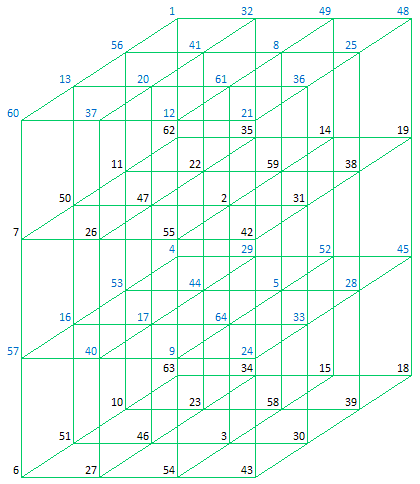Office Applications and Entertainment, Magic Cubes | ||
|
|
Index | About the Author |
|
3.7 Pantriagonal Magic Cubes (4 x 4 x 4)
Magic Cubes as discussed in Section 2.1 for which basically only the rows, columns, pillars and 4 space diagonals (main triagonals) sum to the Magic Constant are normally referred to as Simple Magic Cubes.
|

|
|
|
As a consequence of the defining properties mentioned above, the cube has also following properties:
A Pantriagonal Magic Cube can be transformed into another Pantriagonal Magic Cube by moving an orthogonal plane from one side of the cube to the other.
(Comparable with the row and column movements for Pandiagonal Magic Squares as discussed in 'Magic Squares' Section 3.4).
In general Magic Cubes of order 4 can be represented as follows:
|

|
|
|
The equations for the other orthogonal planes and pantriagonals are comparable.
The complete set of equations results, after deduction, in following set of linear equations describing the "Pantriagonal Magic Cubes" as published by John Hendricks: a(61) = 130 - a(62) - a(63) - a(64) a(59) = 130 - a(60) - a(63) - a(64) a(58) = a(60) - a(62) + a(64) a(57) = - a(60) + a(62) + a(63) a(55) = - a(56) + a(63) + a(64) a(54) = a(56) + a(62) - a(64) a(53) = 130 - a(56) - a(62) - a(63) a(52) = 130 - a(56) - a(60) - a(64) a(51) = a(56) + a(60) - a(63) a(50) = 130 - a(56) - a(60) - a(62) a(49) = -130 + a(56) + a(60) + a(62) + a(63) + a(64) a(47) = 130 - a(48) - a(63) - a(64) a(46) = a(48) - a(62) + a(64) a(45) = - a(48) + a(62) + a(63) a(44) = 130 - a(48) - a(60) - a(64) a(43) = -130 + a(48) + a(60) + a(63) + 2 * a(64) a(42) = 130 - a(48) - a(60) + a(62) - 2 * a(64) a(41) = a(48) + a(60) - a(62) - a(63) + a(64) a(40) = a(48) - a(56) + a(64) a(39) = 130 - a(48) + a(56) - a(63) - 2 * a(64) a(38) = a(48) - a(56) - a(62) + 2 * a(64) a(37) = - a(48) + a(56) + a(62) + a(63) - a(64) a(36) = - a(48) + a(56) + a(60) a(35) = a(48) - a(56) - a(60) + a(63) + a(64) a(34) = - a(48) + a(56) + a(60) + a(62) - a(64) a(33) = 130 + a(48) - a(56) - a(60) - a(62) - a(63) a(32) = 65 - a(56) - a(62) + a(64) a(31) = - 65 + a(56) + a(62) + a(63) a(30) = 65 - a(56) a(29) = 65 + a(56) - a(63) - a(64) a(28) = - 65 + a(56) + a(60) + a(62) a(27) = 195 - a(56) - a(60) - a(62) - a(63) - a(64) a(26) = - 65 + a(56) + a(60) + a(64) a(25) = 65 - a(56) - a(60) + a(63) a(24) = 65 - a(62) a(23) = - 65 + a(62) + a(63) + a(64) a(22) = 65 - a(64) a(21) = 65 - a(63) a(20) = 65 - a(60) + a(62) - a(64) a(19) = 65 + a(60) - a(62) - a(63) a(18) = 65 - a(60) a(17) = - 65 + a(60) + a(63) + a(64) a(16) = 65 - a(48) + a(56) + a(62) - 2 * a(64) a(15) = 65 + a(48) - a(56) - a(62) - a(63) + a(64) a(14) = 65 - a(48) + a(56) - a(64) a(13) = - 65 + a(48) - a(56) + a(63) + 2 * a(64) a(12) = 65 + a(48) - a(56) - a(60) - a(62) + a(64) a(11) = - 65 - a(48) + a(56) + a(60) + a(62) + a(63) a(10) = 65 + a(48) - a(56) - a(60) a( 9) = 65 - a(48) + a(56) + a(60) - a(63) - a(64) a( 8) = 65 - a(48) + a(62) - a(64) a( 7) = 65 + a(48) - a(62) - a(63) a( 6) = 65 - a(48) a( 5) = - 65 + a(48) + a(63) + a(64) a( 4) = - 65 + a(48) + a(60) - a(62) + 2 * a(64) a( 3) = 65 - a(48) - a(60) + a(62) + a(63) - a(64) a( 2) = - 65 + a(48) + a(60) + a(64) a( 1) = 195 - a(48) - a(60) - a(63) - 2 * a(64)
The linear equations shown above, are ready to be solved, for the Magic Constant 130.
0 < a(i) =< 64 for i = 1, 2 ... 47, 49 ... 55, 57 ... 59, 61
which have been incorporated in an optimized guessing routine (MgcCube4d).
| ||||||||||||||||
|
|
Index | About the Author |